Transcranial Magnetic Stimulation (TMS) has emerged as a promising, non-invasive treatment for various mental health conditions, such as depression, anxiety, and obsessive-compulsive disorder. Despite its growing popularity and numerous scientific studies supporting its effectiveness, many misconceptions about TMS persist. This blog aims to debunk five common myths about transcranial magnetic stimulation therapy and shed light on this innovative treatment option.
Myth #1: TMS is a form of electroconvulsive therapy (ECT)
Fact: TMS and ECT are entirely different treatment modalities. While both involve the application of external stimuli to the brain, their methods and side effects are distinct. ECT induces a controlled seizure by passing electrical currents through the brain, whereas TMS uses magnetic fields to stimulate specific brain regions gently. TMS is a non-invasive procedure that does not require anesthesia, has fewer side effects, and does not cause memory loss or cognitive impairments like ECT can.
Myth #2: TMS is only a temporary solution
Fact: TMS has demonstrated long-lasting therapeutic effects in many patients. Studies have shown that the majority of TMS-treated individuals experience a significant reduction in their symptoms, with some even achieving full remission. The duration of TMS benefits varies among individuals, and some may require maintenance treatments to sustain their improvements. It is essential to work closely with a TMS provider to develop a personalized treatment plan.
Myth #3: TMS is unsafe
Fact: TMS has been proven to be a safe and well-tolerated treatment option. The most common side effects include mild headaches and discomfort at the treatment site, which typically subside within the first week of treatment. Serious side effects, such as seizures, are rare and occur in less than 0.1% of patients. TMS has been approved by the FDA for the treatment of depression since 2008 and has been extensively studied for other mental health conditions.
Myth #4: TMS is only for individuals who have failed other treatments
Fact: TMS can be a viable treatment option for individuals at various stages of their mental health journey. While it is true that TMS has demonstrated significant benefits for patients who have not responded well to medications or therapy, it can also be considered earlier in the treatment process. Each patient’s unique circumstances and medical history should be evaluated by a TMS provider to determine the most appropriate course of action.
Myth #5: TMS is painful
Fact: TMS is generally well-tolerated, with most patients reporting minimal discomfort during treatment sessions. The sensation of TMS has been described as a tapping or knocking feeling on the scalp, which tends to become more tolerable over time. Any discomfort experienced during TMS sessions can usually be managed by adjusting the treatment settings or using over-the-counter pain medications.
Transcranial Magnetic Stimulation is a safe, non-invasive, and effective treatment option for various mental health conditions. By debunking these common myths about transcranial magnetic stimulation, we hope to encourage more individuals to consider TMS as a viable treatment alternative. If you are interested in learning more about TMS and whether it could be a suitable option for you, get in touch with PsyFi TMS. Our experienced team is dedicated to providing personalized and compassionate care to help you on your path to mental wellness.


